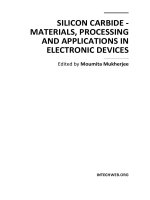Silicon Carbide Materials Processing and Applications in Electronic Devices Part 10 pdf
Bạn đang xem bản rút gọn của tài liệu. Xem và tải ngay bản đầy đủ của tài liệu tại đây (3.47 MB, 35 trang )
Introducing Ohmic Contacts into Silicon Carbide Technology
305
the possible enhancement of electric field at these features and semiconductor doping at
these locations, (3) formation of intermediate semiconductor layer between the deposited
metals and semiconductor, which consists of silicides or carbides, could divide the high
barrier height into lower ones, thus reducing the effective barrier height.
The findings presented first demonstrate that no Al is clearly segregated around the
interfacial region, in particular at the top few layers of SiC, which rules out the possibility of
additional Al doping. Though a small amount of residual Al is found to be present, mostly
in a form of Al
4
C
3
compound, it may locate on the surface of annealed contacts rather than
in the layer directly contacted to the SiC, thus playing a negligible role in Ohmic contact
formation. The majority of deposited Al is evaporated during annealing because of its low
melting point and high equilibrium vapor pressure. The dominant role played by Al in the
TiAl system is to assist the formation of liquid alloy so as to facilitate chemical reaction.
Furthermore, careful characterization of the interfacial region reveals that the substrate and
the generated compound are epitaxially oriented and well matched at interface with no clear
evidence of high density of defects. This suggests that the morphology might not be the key
to understanding the contact formation. In support of this speculation, it has been observed
previously that Ti Ohmic contacts can be possibly generated without any pitting and that
pit-free Ohmic contacts can be fabricated.
One remaining theory is the alloy-assisted Ohmic contact formation. This alloy is
determined to be ternary Ti
3
SiC
2
, which has also been corroborated by other expriments.
Since the bulk Ti
3
SiC
2
has already been found to be of metallic nature both in experiment
and theory, the contact between Ti
3
SiC
2
and its covered metals should show Ohmic
character and thus the SiC/Ti
3
SiC
2
interface should play a significant role in Ohmic contact
formation. This idea is supported by the fact that the determined interface has a lowered
SBH due to the large dipole shift at interface induced by the partial ionicity and the
considerable charge transfer. In addition, the interfacial states, as indicated by the electron
distribution at E
F
, are also viewed as a contributing factor in reducing the SBH. These states
might be further enhanced by the possible presence of point defects at interface, although
these structural defects have not been detected by the TEM study.
The calculations predict that an atomic layer of carbon emerges as the first monolayer of
Ohmic contacts, which eventually affects interface electronic structure. Such trapped carbon
was previously studied in both other interfacial systems theoretically by DFT and the TiNi
Ohmic contacts on 4H-SiC experimentally by Auger electron spectroscopy (Ohyanagi et al.,
2008). It was proposed that the carbon could be segregated to interfacial area, strengthening
interface substantially and reducing Schottky barrier dramatically. Further, it was reported
that the Ohmic contact can be realized by depositing carbon films only onto the SiC
substrate, indicative of the determinative role of carbon in the Ohmic contact formation (Lu
et al., 2003). The important role played by carbon can be traced to the two interfacial Si
layers, which provide possible sites for carbon segregation due to the strong Si-C
interaction. Finally, recent observation shows that atomic-scale Ti
3
SiC
2
-like bilayer can be
embeded in the SiC interior, forming an atomically ordered multilayer that exhibits an
unexpected electronic state with the point Fermi surface. The valence charge is found to be
confined largely within the bilayer in a spatially connected way, which serves as a possible
conducting channel to enhance the current flow over the semiconductor.
Several experimental methods can be used to probe the Ohmic character of Ti
3
SiC
2
contacts
on SiC discussed in this chapter. For example, based on the results regarding morphology of
grown layers, epitaxial Ti
3
SiC
2
layers can be deposited directly onto the SiC substrate by
Silicon Carbide – Materials, Processing and Applications in Electronic Devices
306
means of sputtering, molecular bean epitaxy (MBE), or pulsed-laser deposition (PLD). In
particular, the crucial effect of interfacial carbon can be possibly examined using the MBE
and PLD techniques, which allow a layer-by-layer deposition of crystalline thin films. If the
outcome of such investigations is positive for Ohmic contact formation, direct deposition of
epitaxial Ti
3
SiC
2
thin films rather than the metals would be a potential processing technique
for easier realization of ordered structure and better control of Ohmic property.
To summarize, we have determined in this chapter atomic-scale structure of Ohmic contacts
on SiC and related it to electronic structure and electric property, aimed at understanding
the formation mechanism of Ohmic contact in TiAl-based system. The combined HAADF-
DFT study represents an important advance in relating structures to device properties at an
atomic scale and is not limited to the contacts in SiC electronics. Our results show that the
main product generated by chemical reaction can be epitaxial and have atomic bonds to the
substrate. The contact interface, which could trap an atomic layer of carbon, enables lowered
Schottky barrier due to the large interfacial dipole shift associated with the considerable
charge transfer. These findings are relevant for technological improvement of contacts in SiC
devices, and this chapter presents an important step towards addressing the current contact
issues in wide-band-gap electronics.
5. Acknowledgment
We thank S. Watanabe (Univ. of Tokyo) for allowing our use of computational resources.
The present study was supported in part by a Grant-in-Aid for Scientific Research on
Priority Area, “Atomic Scale Modification (474)” from the Ministry of Education, Culture,
Sports, Science, and Technology of Japan. Z. W acknowledges financial supports from the
Grant-in-Aid for Young Scientists (B) (Grant No. 22760500), the IKETANI Science and
Technology Foundation (Grant No. 0221047-A), and the IZUMI Science and Technology
Foundation. S. T. thanks the supports from Nippon Sheet Glass Foundation and the
MURATA Science Foundation. The calculations were carried out on a parallel SR11000
supercomputer at the Institute for Solid State Physics, Univ. of Tokyo.
6. References
Chang, S. C.; Wang, S. J.; Uang, K. M. & Liou, B. W. (2005). Investigation of Au/Ti/Al
Ohmic Contact to N-type 4H-SiC, Solid State Electronics, Vol.49, No.12, (December
2005), pp. 1937-1941, ISSN 0038-1101
Ching, W. Y.; Xu, Y. N.; Rulis, P. & Ouyang, L. Z. (2006). The Electronic Structure and
Spectroscopic Properties of 3C, 2H, 4H, 6H, 15R and 21R Polymorphs of SiC,
Materials Science and Engineering A, Vol.422, No.1-2, (April 2006), pp. 147-156, ISSN
0921-5093
Gao, M.; Tsukimoto, S.; Goss, S. H.; Tumakha, S. P.; Onishi, T.; Murakami, M. & Brillson, L.
J. (2007). Role of Interface Layers and Localized States in TiAl-Based Ohmic
Contacts to p-Type 4H-SiC, Journal of Electronic Materials, Vol.36, No.4, (April 2007),
pp. 277-284, ISSN 0361-5235
Harries, G. L. (1995). Silicon Carbide, INSPEC, ISBN 0-85296-870-1, London, United
Kingdom
Introducing Ohmic Contacts into Silicon Carbide Technology
307
Johnson, B. J. & Capano, M. A. (2004). Mechanism of Ohmic Behavior of Al/Ti Contacts to
p-type 4H-SiC After Annealing, Journal of Applied physics, Vol.95, No.10, (May 2004),
pp. 5616-5620, ISSN 0021-8979
Käckell, P.; Wenzien, B. & Bechstedt, F. (1994). Electronic Properties of Cubic and Hexagonal
SiC Polytypes from ab initio Calculations, Physical Review B, Vol.50, No.15, (October
1994), pp. 10761-10768, ISSN 1098-0121
Kresse, G. & Hafner, J. (1993). Ab initio Molecular Dynamics for Liquid Metals, Physical
Review B, Vol.47, No.1, (January 1983), pp. 558-561, ISSN 1098-0121
Lu, W.; Mitchel, W. C.; Thornton, C. A.; Collins, W. E.; Landis, G. R. & Smith, S. R. (2003),
Ohmic Contact Behavior of Carbon Films on SiC, Journal of The Electrochemical
Society, Vol.153, No.3, (January 2003), pp. G177-G182, ISSN 0013-4651
Mohney, S. E.; Hull, B. A.; Lin, J. Y. & Crofton, J. (2002). Morphological study of the Al-Ti
Ohmic Contact to p-type SiC, Solid State Electronics, Vol.46, No.5, (May 2002), pp.
689-693, ISSN 0038-1101
Morkoc, H.; Strite, S.; Gao, G. B.; Lin, M. E.; Sverdlov, B. & Burns, M. (1994). Large-band-gap
SiC, III-V Nitride, and II-VI ZnSe-based Semiconductor Device Technologies,
Journal of Applied physics, Vol.76, No.3, (August 1994), pp. 1363-1398, ISSN 0021-
8979
Nakatsuka, O.; Takei, T.; Koide, Y. & Murakami, M. (2002). Low Resistance TiAl Ohmic
Contacts with Multi-Layered Structure for p-Type 4H-SiC, Materials Transactions,
Vol.43, No.7, (July 2002), pp. 1684-1688, ISSN 1345-9678
Nellist, P. D.; Chisholm, M. F.; Dellby, N.; Krivanek, O. L.; Murfitt, M. F.; Szilagyi, Z. S.;
Lupini, A. R.; Borisevich, A.; Sides, Jr. W. H. & Pennycook, S. J. (2004). Direct Sub-
Angstronm Imaging of a Crystal Lattice, Science, Vol.305, No.5691, (September
2004), pp. 1741, ISSN 0036-8075
Ohyanagi, T.; Onose, Y. & Watanabe, A. (2008). Ti/Ni Bilayer Ohmic Contact on 4H-SiC,
Journal of Vacuum Science and Technology B, Vol.26, No.4, (August 2008), pp. 1395-
1362, ISSN 1071-1023
Pennycook, S. J. & Boatner L. A. (1988). Chemically Sensitive Structure-Imaging with a
Scanning Transmission Electron Microscope, Nature, Vol.336, No.6199, (December
1988), pp. 565-567, ISSN 0028-0836
Perez-Wurfl, I.; Krutsinger, R.; Torvik, J. T. & Van Zeghbroeck, B. (2003). 4H-SiC Bipolar
Junction Transistor with High Current and Power Density, Solid State Electronics,
Vol.47, No.2, (February 2003), pp. 229-231, ISSN 0038-1101
Tanimoto, S.; Kiritani, N.; Hoshi, M. & Okushi, H. (2002). Ohmic Contact Structure and
Fabrication Process Applicable to Practical SiC Devices, Materials Science Forum,
Vol.389-393, No.2, (January 2002), pp. 879-884, ISSN 0255-5476
Tsukimoto, S.; Nitta, K.; Sakai, T.; Moriyama, M. &Murakami, M. (2004). Correlation
Between the Electrical Properties and the Interfacial Microstructurs of TiAl-Based
Ohmic Contacts to p-type 4H-SiC, Journal of Electronic Materials, Vol.33, No.5, (May
2004), pp. 460-466, ISSN 0361-5235
Viala, J. C.; Peillon, N.; Bosselet, F. & Bouix, J. (1997). Phase Equilibra at 1000˚C in the Al-C-
Si-Ti Quaternary system: an Experiemtnal Approach, Materials Science and
Engineering A, Vol.229, No.1-2, (June 1997), pp. 95-113, ISSN 0921-5093
Silicon Carbide – Materials, Processing and Applications in Electronic Devices
308
Wang, X. G.; Smith, J. R. & Evans, A. (2002), Fundamental Inflenence of C on Adhesion of
the Al
2
O
3
/Al Interface, Physical Review Letters, Vol.89, No.28, (December 2002), pp.
286102-1-4, ISSN 0031-9007
13
SiC-Based Composites Sintered with
High Pressure Method
Piotr Klimczyk
Institute of Advanced Manuacturing Technology
Poland
1. Introduction
Silicon carbide-based materials usually have high hardness (2500 – 2800 HV) and thus have
superior wear resistance. Nevertheless, the tribological performance of SiC is determined by
many factors, such as the grain size of mated materials or the reactions in the presence of
oxygen and humidity in the surrounding atmosphere. For example, in unlubricated sliding,
wear resistance of SiC ceramics can be greater in air than in inert atmosphere owing to thin
soft oxide films reducing friction and local surface pressure. (Gahr et al., 2001; Guicciardi et
al., 2007). The friction and wear properties of SiC materials (both in dry and lubricating
conditions) have been studied extensively because they are used in applications like
bearings, cylinder liners and mechanical seals (Murthy et al., 2004).
Silicon carbide-based ceramics have high melting point (~2500 °C), high thermal
conductivity (43 – 145 W/m·K – depending on a temperature and phase composition), low
thermal expansion (~4,5×10
-6
·K
-1
), and high temperature capability. Silicon carbide is a
semiconductor which can be doped n-type by nitrogen or phosphorus and p-type by
aluminium, boron, gallium or beryllium. Due to the combination of its thermal and electrical
properties, SiC is applied in a resistance heating, flame igniters and electronic components.
Relatively pure SiC has also an excellent corrosion resistance in the presence of hot acids
and bases (Richerson, 2004).
Silicon carbide powder compacts are difficult to densify without additives because of the
covalent nature of the Si–C bonds and the associated low self-diffusion coefficient.
Therefore, Reaction Sintering (RS) in the presence of liquid silicon as well as Hot Isotactic
Pressing (HIP) are frequently used to obtain a high quality, full dense SiC ceramics.
Typical room temperature flexural strength of SiC-based materials is about 350-550 MPa.
High-strength RS-SiC (over 1000 MPa in a 3-point bending test) was developed by
controlling the residual Si size under 100 nm. (Magnani et al., 2000; Suyama et al., 2003).
Silicon carbide ceramics have the ability to increase in strength with increase of
temperature. It was reported that flexural strength of some kind of commercial SiC
ceramic increase is from 413 MPa at the room temperature to around 580 MPa at 1800 °C
(Richerson, 2004). For hot-pressed silicon carbide with addition of 0.15-1.0 wt% Al
2
O
3,
the high-temperature strength has been improved from 200 MPa to 700 MPa by
decreasing the grain boundary concentration of both Al and O at 1500 °C (Kinoshita et
al., 1997).
Silicon Carbide – Materials, Processing and Applications in Electronic Devices
310
A favorable combination of properties makes SiC materials suitable for many engineering
applications, including parts of machines and devices exposed to the abrasion, the high
temperature, the corrosive environment, etc. A major disadvantage of SiC ceramic materials
is their low fracture toughness, which usually does not exceed about 3.5 MPa·m
1/2
(Lee et al.,
2007; Suyama et al., 2003). Low values of K
Ic
coefficient exclude these materials from
numerous applications with dynamic loads, e.g. in machining processes.
There are various ways to improve the fracture toughness of ceramic materials. One of them
involves obtaining a composite material by the introduction of the additional phases in the
form of nano-, micro- or sub-micro-sized particles to the base material. Some papers indicate
that nanosized structures have great potential to essentially improve the mechanical
performance of ceramic materials even at high temperatures (Awaji et al., 2002; Derby, 1998;
Kim et al., 2006; Niihara et al., 1999). Depending on the type of introduced particles,
composites can take advantage of different strengthening mechanisms, such as the crack
deflection, crack bridging, crack branching, crack bowing, crack pinning, microcracking,
thermal residual stress toughening, transformation toughening and synergism toughening.
For example, metallic particles are capable of plastic deformation, thus absorption of energy
and bridging of a growing crack, resulting in increased strengthening (Fig. 1a) (Yeomans,
2008). On the other hand, hard ceramic particles, like borides or nitrides, can introduce a
favorable stress state which can cause a toughening effect by crack deflection and crack
bifurcation (Fig. 1b) (Xu, 2005). An addition of metal borides such as ZrB
2
, TaB
2
, NbB
2
or
TiB
2
, promote densification of SiC powder as well as improve hardness and other
mechanical properties of the material as a whole (Tanaka et al., 2003).
Fig. 1. Example of strengthening mechanisms which can occur in ceramic matrix composites
with dispersed “soft” metallic or/and “hard” ceramic particles: a) crack bridging, b) crack
deflection and crack bifurcation
The wide group of materials containing the silicon carbide are SiC/Si
3
N
4
composites. In
such materials predominant phase is silicon nitride, while SiC content does not usually
exceed 30 vol.%. Silicon nitride has a lower hardness but a higher fracture toughness than
silicon carbide. If SiC particles are uniformly dispersed in the Si
3
N
4
ceramics, high strength
can be obtained from room temperature to elevated temperature. It was reported that the
strength of 1000 MPa at 1400°C is obtained in nano-composites having ultra-fine SiC
particles added into the Si
3
N
4
matrix. This improvement was mainly attributed to the
suppression of a grain boundary sliding by intergranular SiC particles bonded directly with
the Si
3
N
4
grain in the atomic scale without any impurity phases (Hirano & Niihara, 1995;
Yamada & Kamiya, 1999). SiC/Si
3
N
4
composites have an ability to crack healing under high
temperature and applied stress, to exhibit a significantly higher creep resistance and fracture
SiC-Based Composites Sintered with High Pressure Method
311
toughness compared to the monolithic materials. (Ando et al., 2002; Lojanová et al., 2010;
Sajgalík et al., 2000; Takahashi et al., 2010).
The combination of the fair fracture toughness with high hardness, wear resistance and
mechanical strength at elevated temperatures makes SiC/Si
3
N
4
ceramics a promising
material for cutting tools (Eblagon et al., 2007). Despite many studies on materials based on
silicon carbide and silicon nitride, there is a lack of knowledge about the SiC/Si
3
N
4
composites where the predominant phase is SiC. In the presented work, the materials
contained from 0 to 100% of silicon carbide were investigated.
2. Description of experiment
The purpose of the presented experiment was to study the influence of High Pressure - High
Temperature (HPHT) sintering on the phase composition, microstructure and selected
properties of SiC/Si
3
N
4
composites as well as to study the effect of the addition of third-
phase particles selected from metals (Ti) or ceramics (TiB
2
, cBN - cubic Boron Nitride) to the
SiC – Si
3
N
4
system. The main goal was to improve fracture toughness and wear resistance of
the investigated materials.
The composites were manufactured and tested in two stages. The first stage consisted in
sintering of materials having, in its initial composition, only SiC and/or Si
3
N
4
powder(s).
Samples sintered from nano-, sub-micro- and micropowders with various silicon carbide to
silicon nitride ratios were investigated at this stage.
At the second stage the best SiC/Si
3
N
4
composite manufactured at the first stage was
subjected to modification, consisting of:
- use of various types of SiC and Si
3
N
4
powders,
- addition of metallic phase in the form of Ti particles,
- addition of boride (TiB
2
) phase,
- addition of superhard (cBN) phase.
All materials were sintered with the HPHT method. The parameters of sintering: time and
temperature were chosen individually for each composition. The obtained samples were
subjected to a series of studies, which included: phase composition and crystallite size
analysis by X-ray diffraction, measurements of density by hydrostatic method and Young's
modulus by the ultrasonic method, measurement of hardness and and fracture toughness
using Vickers indentation as well as studies of tribological properties using the Ball-On-Disk
method.
2.1 HPHT method of sintering
Pressure is a versatile tool in solid state physics, materials engineering and geological
sciences. Under the influence of high pressure and temperature there are a lot of changes in
physical, chemical and structural properties of materials (Eremets, 1996). It gives a
possibility to generate of new, non-existent in nature phases, or phases which occur only in
inaccessible places, such as the earth core (Manghnani et al., 1980). The use of pressure as a
parameter in the study of materials was pioneered principally by Professor P. W. Bridgman,
who for forty years investigated most of the elements and many other materials using
diverse techniques (Bridgman, 1964). There are many design solutions to ensure High
Pressure - High Temperature (HPHT) conditions for obtaining and examination of
materials. Depending on the design assumptions, it is possible to achieve very high
pressures, up to several hundred gigapascals, as in the case of Diamond Anvils Cell (DAC).
Silicon Carbide – Materials, Processing and Applications in Electronic Devices
312
Such devices, due to their small size, are intended solely for laboratory investigations (XRD
in-situ study, neutron diffraction etc.) (Piermarini, 2008). For the purposes of industrial and
semi-industrial production of materials the most frequently the “Belt” or “Bridgman” type
of equipment is used (Eremets, 1996; Hall, 1960; Khvostantsev et al., 2004). These
apparatuses provide a relatively large working volume, the optimum pressure distribution
and the possibility of achieving high temperatures.
In the toroidal type of Bridgman apparatus the quasi-hydrostatic compression of the
material is achieved as a result of plastic deformation of the so called “gasket” (Fig. 2).
Fig. 2. Sintering process in a Bridgman-type HPHT system. Quasi-hydrostatic compression
of the preliminary consolidated powders (sample - 1) is achieved as a result of plastic
deformation of the gasket material (2) between anvils (3); electrical heating is provided by a
high-power transformer (4) and graphite resistive heater (5)
Gaskets are made of special kinds of metamorphic rocks such as pyrophyllite, “lithographic
stone” or catlinite (Filonenko & Zibrov, 2001; Prikhna, 2008). The toroidal chamber,
depending on its volume (usually from od 0.3 do 1 cm
3
), can generate pressures up to 12
GPa and temperature up to ~2500 °C. The presented system is used often for production of
SiC-Based Composites Sintered with High Pressure Method
313
synthetic diamonds and for sintering of wide range of superhard composites based on
polycrystalline diamond (PCD) or polycrystalline cubic boron nitride (PcBN). Under the
influence of a simultaneous action of pressure and temperature the sintering process occurs
much faster than in the case of free sintering. A typical duration of sintering process with
HPHT method is about 0.5 – 2 minutes (Fig. 3) while the free sintering requires several
hours. Short duration of the process contributes to the grain growth limitation, which is
essential in the case of sintering of nanopowdes. The materials obtained with HPHT method
are characterized by almost a 100% level of densification, isotropy of properties and
sometimes by a completely different phase composition in relation to the same free-sintered
materials, due to the different thermodynamic conditions of the manufacturing process.
0 30 60 90 120 150 180 210 240 270 300 330 360 390
0
1
2
3
4
5
Load
Power
Time, s
Power, kVA
1
2
3
0
10
20
30
40
50
60
70
80
90
100
Load, ×0.2 MN
Fig. 3. Three stages of an example process of HPHT sintering: 1 – loading, 2 – sintering,
3 – unloading
Silicon Carbide – Materials, Processing and Applications in Electronic Devices
314
2.2 Samples preparation
Powders used for the preparation of mixtures for sintering of SiC/Si
3
N
4
materials are listed
in Table 1.
Powder Category
Particle size
[µm]
Manufacturer Description
SiC nano <5 nm France beta
SiC sub-micro 0.1 – 1 Goodfellow, UK alpha
SiC micro 1.2 AGH, Poland
Si
3
N
4
nano <20nm Goodfellow, UK amorphous
Si
3
N
4
sub-micro 0.1 – 0.8 Goodfellow, UK alpha
Si
3
N
4
sub-micro 0.6 H.C. Starck, Germany alpha>90%, M11-grade
Si
3
N
4
micro 1 – 5 AEE, USA alpha>85%
TiH
2
micro <44 Fluka, Switzerland
TiB
2
micro 2.5 – 3.5 H.C. Starck, Germany F-grade
cBN nano 0 – 0.1 Element6, South Africa Micron+ABN, M0.10-grade
cBN micro 3 – 6 Element6, South Africa Micron+ABN, M36-grade
Table 1. Powders used for preparation of mixtures for sintering of SiC/Si
3
N
4
materials
The following mixtures were prepared by mixing the appropriate powders (Table. 1) in an
isopropanol environment using the Fritsch Pulverisette 6 planetary mill.
nano-SiC/Si
3
N
4
materials
100 % SiC(nano)
100 % Si
3
N
4
(nano)
50 SiC(nano)/50 Si
3
N
4
(nano) – vol.%
sub-micro-SiC/Si
3
N
4
materials
95 SiC(sub-micro)/5 Si
3
N
4
(sub-micro, Starck) – vol.%
70 SiC(sub-micro)/30 Si
3
N
4
(sub-micro, Starck) – vol.%
50 SiC(sub-micro)/50 Si
3
N
4
(sub-micro, Starck) – vol.%
100 % Si
3
N
4
(sub-micro, Starck)
micro-SiC/Si
3
N
4
materials
70 SiC(micro)/30 Si
3
N
4
(micro) – vol.%
100 % Si
3
N
4
(micro)
70SiC/30Si
3
N
4
composite (modification by using various SiC and Si
3
N
4
powders)
70 SiC(sub-micro)/30 Si
3
N
4
(sub-micro, Starck) – vol.%
70 SiC(sub-micro)/30 Si
3
N
4
(sub-micro, Goodfellow) – vol.%
70 SiC(micro)/30 Si
3
N
4
(micro) – vol.%
70 SiC(sub-micro)/30 Si
3
N
4
(micro) – vol.%
70SiC/30Si
3
N
4
composite + Ti (modification by addition of the third, metallic phase)
70 SiC(sub-micro)/30 Si
3
N
4
(sub-micro, Starck) + 8 vol.% Ti - from TiH
2
(micro)
70SiC/30Si
3
N
4
composite + TiB
2
(modification by addition of the third, boride phase)
70 SiC(sub-micro)/30 Si
3
N
4
(sub-micro, Starck) + 8 vol.% TiB
2
(micro)
70 SiC(sub-micro)/30 Si
3
N
4
(sub-micro, Starck) + 30 vol.% TiB
2
(micro)
SiC-Based Composites Sintered with High Pressure Method
315
70SiC/30Si
3
N
4
composite + cBN (modification by addition of the third, nitride phase)
70 SiC(sub-micro)/30 Si
3
N
4
(sub-micro, Starck) + 8 vol.% cBN(micro)
70 SiC(sub-micro)/30 Si
3
N
4
(sub-micro, Goodfellow) + 8 vol.% cBN(nano)
70 SiC(sub-micro)/30 Si
3
N
4
(sub-micro, Starck) + 30 vol.% cBN(micro)
After drying, the mixtures were preliminarily compressed into a disc of r 15 mm diameter
and 5 mm height under pressure of ~200 MPa. The green bodies with the addition of TiH
2
were additionally annealed in a vacuum at a temperature of 800 °C for 1h in order to
remove the hydrogen and obtain pure metallic titanium. The materials were obtained at
high pressure (6 GPa) in the wide range of temperatures ( 430 – 2150 °C depending of
composition) using a Bridgman-type toroidal apparatus (Fig. 2). The sintering temperatures
were established experimentally for each material to obtain crack-free samples with the
highest values of density and mechanical properties. The duration of the sintering process
was 40s for nanopowders and 60 s for the others.
The sintered compacts were subsequently ground to remove remains of graphite after the
technological process of sintering and to obtain the required quality and surface parallelism
for Young’s modulus determination. The samples provided for microscopic investigations
and for mechanical tests were additionally polished using diamond slurries.
2.3 Investigation methods
Densities of the sintered samples were measured by the hydrostatic method. The
uncertainty of the measurements was below 0.02 g/cm
3
, which gave a relative error value
of below 0.5 % (excluding measurements of small pieces of broken samples, where the error
was up to 0.1 g/cm
3
, due to their insufficient volume and mass).
Young’s modulus of the samples obtained by HPHT sintering was measured by means of
transmission velocity of ultrasonic waves through the sample, using a Panametrics Epoch III
ultrasonic flaw detector. Calculations were carried out according to (Eq. 1):
22
2
22
3-4
-
LT
T
LT
CC
EC
CC
=⋅ρ (1)
where: E - Young’s modulus, C
L
- velocity of the longitudinal wave, C
T
- velocity of the
transversal wave, ρ - density of the material.
The velocities of transverse and longitudinal waves were determined as a ratio of sample
thickness and relevant transition time. The accuracy of calculated Young’s modulus (Eq. 1)
was estimated to be below 2 %.
Hardness of sintered samples was determined by the Vickers method using a digital Vickers
Hardness Tester (FUTURE-TECH FV-700). Five hardness measurements, with indentation
loads of 2.94, 9.81 and 98.1 N, were carried out for each sample. Standard deviations of HV
values were relatively high but usually no more than 5 % of the average values.
Indentation fracture toughness was calculated from the length of cracks which
developed in a Vickers indentation test (with indentation load - 98.1 N) using Niihara’s
equation (Eq. 2):
2
3
5
2
0 129.
K
Hc
Ic
Ea
Ha
ϕ
ϕ
−
=⋅
(2)
Silicon Carbide – Materials, Processing and Applications in Electronic Devices
316
where: K
Ic
- critical stress intensity factor,
ϕ
- constrain factor, H - Vickers hardness,
E - Young’s modulus, a - half of indent diagonal, c - length of crack.
Microstructural observations were carried out on the densified materials using a JEOL JXA-
50A Scanning electron Microscope equipped with back scattering electron (BSE) imaging.
In the Ball-On-Disc tests, the coefficient of friction and the specific wear rate of the sintered
samples in contact with Si
3
N
4
ball were determined using a CETR UMT-2MT (USA)
universal mechanical tester. In the Ball-On-Disc method, sliding contact is brought about by
pushing a ball specimen onto a rotating disc specimen under a constant load (Fig. 4). The
loading mechanism applied a controlled load F
n
to the ball holder and the friction force was
measured continuously during the test using an extensometer. For each test, a new ball was
used or the ball was rotated so that a new surface was in contact with the disc. The ball and
disc samples were washed in ethyl alcohol and dried.
Fig. 4. Material pair for the Ball-On-Disc method: 1 – Si
3
N
4
ball; 2 – sample (disc)
The size of the disc-shaped samples was ~13.5 in diameter and ~3.8 mm in height with the
surfaces flatness and parallelism within 0.02 mm. The roughness of the tested surface was
not more than 0.1 µm R
a
. The following test conditions were established: ball diameter – 2
mm, applied load – 4 N, sliding speed – 0.1 m/s, diameter of the sliding circle – 2 ÷ 5 mm,
sliding distance – 100 m, calculated duration of the test – 1000 s. The tests were carried out
without lubricant at room temperature. Each test was repeated at least three times.
Coefficient of friction was calculated from (Eq. 3):
f
n
F
F
μ
=
(3)
where: µ – coefficient of friction, F
f
– measured friction force, F
n
– applied normal force.
After completing the test, according to ISO 20808:2004 E standard, the cross-sectional profile
of the wear track at four places at intervals of 90° was measured using a contact stylus
profilometer PRO500 (CETR, USA). Then the average cross-sectional area of the wear track
was calculated. The volume of material removed was calculated as a product of cross-
sectional area of the wear track and their circumference. Specific wear rate was calculated
from (Eq. 4):
SiC-Based Composites Sintered with High Pressure Method
317
s
n
V
W
FL
=
⋅
(4)
where: W
s
- specific wear rate, V – volume of removed material, L – sliding distance.
3. Materials sintered from nano-, sub-micro-, and micro-SiC/Si
3
N
4
powders
A macroscopic view, phase composition and crystallite size of materials sintered from
nanopowders under the pressure of 6 GPa at temperatures ranging from 430 to 1880 ° C in
the period of time 40s are shown in Table 2.
Initial
powders
β-SiC powder,
4.1 nm
Si
3
N
4
amorphous
powder, < 20 nm
Composite:
50 SiC/50 Si
3
N
4
- vol.%
Temperature
of sintering
Sintered material: appearance, phase composition, crystallite size
430°C
-
amorphous Si
3
N
4
-
650°C
β-SiC (4.1 nm)
amorphous Si
3
N
4
β-SiC (4.5 nm) + amorphous Si
3
N
4
890°C
β-SiC (4.1 nm)
amorphous Si
3
N
4
β-SiC (11.1 nm) + amorphous Si
3
N
4
1170°C
β-SiC (4.4 nm)
orthorhombic
Si
1.8
Al
0.2
O
1.2
N
1.8
(77)
β-SiC (8.0 nm) + orthorhombic
Si
1.8
Al
0.2
O
1.2
N
1.8
(20.0 nm)
Silicon Carbide – Materials, Processing and Applications in Electronic Devices
318
Initial
powders
β-SiC powder,
4.1 nm
Si
3
N
4
amorphous
powder, < 20 nm
Composite:
50 SiC/50 Si
3
N
4
- vol.%
Temperature
of sintering
Sintered material: appearance, phase composition, crystallite size
1450°C
β-SiC (10.6 nm)
β-Si
3
N
4
(77.4 nm)
β-SiC (10.2 nm) + orthorhombic
Si
1.8
Al
0.2
O
1.2
N
1.8
(31.0 nm)
1880°C
β-SiC (110 nm)
β-Si
3
N
4
(143 nm)
β-SiC (51.8 nm) + β-Si
3
N
4
(86.9 nm)
Table 2. A macroscopic view, phase composition and crystallite size of SiC/Si
3
N
4
materials
sintered from nanopowders under the pressure of 6 GPa at temperatures ranging from
430 to 1880 ° C in the period of time 40s
The initial crystallite size of sintered SiC nanopowder was about 4.1 nm and did not change
until the sintering temperature of 1170 °C. At the sintering temperature of 1450°C
crystallites reached an average size of 10.6 nm while at the maximum applied temperature
(1880 °C) their size was 110 nm. This material showed no phase transformation. The sinters
obtained at 1880 °C as well as the initial powder have the cubic structure of β-SiC phase.
Sintered Si
3
N
4
powder remained amorphous until the temperature of 890 °C. At the
temperature of 1170 °C a new phase crystallized. The X-ray diffraction pattern of this phase
corresponds to the o'-sialon with orthorhombic structure and Si
1.8
Al
0.2
O
1.2
N
1.8
stoichiometry.
As evidenced by the chemical formula, this compound has a low content of aluminum with
reference to silicon while the quantities of nitrogen and oxygen are comparable. It can be
assumed that o'-sialon is a transition phase between the amorphous silicon nitride and a
completely crystalline β-Si
3
N
4
phase. O'-sialon was formed probably due to embedding a
certain amount of oxygen and impurities adsorbed on the surface of powder to an atomic
lattice of crystallizing silicon nitride. The crystallite size of this phase was estimated to
around be 77 nm. The samples obtained at temperatures of 1450 and 1880 °C contain only β-
Si
3
N
4
phase with the crystallite size 77.4 and 143 nm respectively.
50 SiC/50 Si
3
N
4
– vol.% nanocomposite was sintered at the same temperatures as silicon
carbide powder without additions. The phase composition of sintered composites did not
differ qualitatively from the sum of their components sintered separately. There was no
formation of new phases in the reaction between silicon carbide and silicon nitride. Sintering
of composites, especially at higher temperatures, leads to lower grain growth than it is in
single-phase powders sintered separately. This indicates a favorable effect of inhibiting
grain growth in the composite.
SiC-Based Composites Sintered with High Pressure Method
319
The comparison of physical-mechanical properties of nano-, sub-micro- and micro-SiC/Si
3
N
4
materials sintered at different temperatures is presented in Fig. 5 and Table 3. Generally,
nanocomposites are characterized by the lowest physical-mechanical properties of the three
granulometric types of the investigated materials. Densities and Young’s modulus values of
the best nanostructured samples do not exceed 2.55 g/cm
3
and 135 GPa respectively. In most
cases, nanostructured SiC/Si
3
N
4
samples are characterized by a lot of cracks (see Table 2).
Cracking of such ceramics occurs as a result of the presence in their structure of residual
micro- and macro-stresses which overcome the strength of the produced material. The fine
powder is characterized by a very large specific surface and high gas content in the sample
due to the absorption process of the material particles. During heating, as a result of the
increase in temperature, the volume of gases increases, which causes cracking or even
permanent fragmentation of the sample. In order to prevent the cracking phenomena in the
samples, various conditions of the sintering process were tested. Depending on composition,
materials characterized by the highest level of densification and the best mechanical properties
were obtained at different temperatures: 890 °C for pure Si
3
N
4
and 1880 °C for 50 Si
3
N
4
/50 SiC
– vol.% composite. Unfortunately, some of these samples had cracks as well. Different kinds of
internal cracks, delamination and other defects of microstructure occurred in most of the nano-
structured samples. These defects cause a scattering of caustic waves propagated through the
material and, in consequence, the impossibility of Young’s modulus measurements using
ultrasonic probes (marked as **nm in Table 3).
Composites without cracks were obtained only from micro- and sub-micro-structured
powders. Only for these composites hardness and fracture toughness were measured.
2.30
2.40
2.50
2.60
2.70
2.80
2.90
3.00
3.10
3.20
3.30
400
600
800
1000
1200
1400
1600
1800
2000
2200
Density, g/ccm
Sintering temperature, °C
0
50
100
150
200
250
300
350
400
450
500
400
600
800
1000
1200
1400
1600
1800
2000
2200
Youngs modulus, GPa
Sintering temperature, °C
Fig. 5. Density and Young modulus of nano-, sub-micro-, and micro-SiC/Si
3
N
4
materials
sintered at different temperatures
Silicon Carbide – Materials, Processing and Applications in Electronic Devices
320
Sample
composition
Sintering temp.
range
*Sinterin
g
temp.
optimal
for
(properties
)
/descript-
tion
Density
Youngs
modulus
Poisson's ratio
Hardness
Fracture toughness
vol.% °C °C
g/ccm
% of theoretic
GPa
% of theoretic
- HV
0.3
HV
1
HV
10
MPa·m
1/2
nanomaterials (initial powders: β-SiC<5nm, amorphous Si
3
N
4
<20nm) sintered at 6GPa
for 40s
100 SiC(nano)
650-
1880
1450
/cracks
2.78 87 172 38 0.24 - - - -
50 SiC(nano)
/50 Si
3
N
4
(nano)
650-
1880
1880
/small
chi
pp
in
g
2.49 78
**nm
-
**nm
- - - -
100 Si
3
N
4
(nano)
430-
1880
890 2.54 80 135 42 0.24 - - - -
sub-micro-structured materials (powders: α-SiC 0.1-1µm, α-Si
3
N
4
0.6µm) sintered at 6GPa
for 60s
95 SiC(sub-micro)
/5 Si
3
N
4
(sub-micro, Starck)
1690-
2150
1880
/cracks
3.18 99 407 92 0.17 - - - -
70 SiC(sub-micro)
/30Si
3
N
4
(sub-micro, Starck)
1690-
2030
*1690
(KIc)
3.14 98 363 87 0.19 2810 2630 2240
5.6
*1880 (
ρ
,
E, HV)
3.18 99 377 90 0.19 3130 2970 2400
4.9
50 SiC(sub-micro)
/50Si
3
N
4
(sub-micro, Starck)
1450-
1880
1690 3.18 99 349 91 0.21 2700 2560 2140 5
100Si
3
N
4
(sub-micro, Starck)
1170-
1690
/cracs - - - - - - - - -
micro-structured materials (initial powders: SiC 1.2 µm, α-Si
3
N
4
1-5 µm,) sintered at 6GPa
for 60s
70 SiC(micro)
/30 Si
3
N
4
(micro)
1450-
1880
1450
/small
cracks
3.02 94 243 58 0.16 - 1880 1510 4.6
100 Si
3
N
4
(micro)
890-
1880
*1450 (ρ)
3.03 95
167 52 0.2 - 1250 1060 4.8
*1690 (E)
/
small
chi
pp
in
g
2.95 92
223 70
0.22 - - - -
Table 3. Physical-mechanical properties of selected nano-, sub-micro- and micro-SiC/Si
3
N
4
materials sintered at optimal temperatures; *optimum temperature for selected properties,
e.g. 1690 (K
Ic
) - the best fracture toughness; **nm - non measurable with ultrasonic method
SiC-Based Composites Sintered with High Pressure Method
321
Si
3
N
4
based ceramics SiC based ceramics
Sub-micro-
70SiC/30Si
3
N
4
composites
(this work)
StarCeram N 7000
H.C. Starck
StarCeram N 8000
H.C. Starck
EKatherm
Ceradyne
Ceralloy 147-A
Ceradyne
StarCeram S
H.C. Starck
Hexoloy SA
Saint Gobain
Ceralloy 146-S5
Ceradyne
Density,
g/ccm
>3.22 >3.23 >3.24 3.18 3.10 3.10 3.20
3.14 3.18
Young’s
modulus,
GPa
290 310 310 310 395 410 430
363 377
Vickers
hardness,
HV
1500 1520
1450
(300g)
1650
(300g)
2500
2800
(100g
Konopp
)
2600
(300g)
2812
(300g)
3132
(300g
)
Fracture
toughness,
MPa·m
1/2
6.7 6.0 7.0 4.5 3.0 4.6 4.3
5.6 4.9
Table 4. Comparison of commercial advanced SiC/Si
3
N
4
-based ceramics
1
with sub-micro-
structured 70 SiC/30 Si
3
N
4
– vol.% composites obtained by HPHT sintering
The composites obtained from submicron powders are characterized by the best properties.
Density and Young’s modulus of the best 70 SiC/30 Si
3
N
4
– vol.% compacts sintered at 1880
°C were 3.18 g/cm
3
and 377 GPa respectively (over 99% and 90% of the theoretical values).
This material is also characterized by the highest hardness (HV1 ~3000) and relatively good
fracture toughness (4.9 MPa·m
1/2
). The same material sintered at a lower temperature (1690
°C) has slightly lower values of density (3.14 g/cm
3
), Young’s modulus (363 GPa) and
hardness (HV1 2626) but higher fracture toughness (5.6 MPa·m
1/2
) - Table 3. HPHT sintered
sub-micro-70 SiC/30 Si
3
N
4
– vol.% composites have a better combination of mechanical
properties than comparable commercial materials (Table 4).
The composites obtained from the micro-sized powders have their properties intermediate
between the nano- and sub-micro-structured materials. Even though the best micro-SiC/Si
3
N
4
samples are crack free and have fairly good density (>94% of theoretical values) and
indentation fracture toughness (4.6 – 4.8 MPa·m
1/2
), their Young’s modulus and hardness are
much lower than for the sub-micro-structured samples. The insufficient mechanical properties
of microstructured Si
3
N
4
–SiC materials can be attributed not only to grain size but also to
specific properties of the initial powder resulting from their production method (e.g. shape of
the grains, impurities, oxidation etc.). The choice of suitable initial powders for the given
method of sintering is the critical factor in achieving good quality of ceramics.
1
Data from: H.C. Starck Ceramics GmbH& Co. KG, Ceradyne Inc. and Saint – Gobain Advanced
Ceramics – commercial data sheets)
Silicon Carbide – Materials, Processing and Applications in Electronic Devices
322
For all the investigated samples, independently of their grain size, a strong influence of
indentation load on hardness values can be observed. Increasing the indentation load causes
a decrease in hardness values (Table 3).
4. Modifications of 70 SiC/30 Si
3
N
4
composite
Density and Young’s modulus of various 70 SiC/30 Si
3
N
4
– vol.% composites sintered at
different temperatures with and without additions of Ti, TiB
2
and cBN phases are presented
in Figs 6-11 and in Table 5.
2.90
2.92
2.94
2.96
2.98
3.00
3.02
3.04
3.06
3.08
3.10
3.12
3.14
3.16
3.18
3.20
3.22
1400
1500
1600
1700
1800
1900
2000
2100
Density, g/ccm
Sintering temperature, °C
200
220
240
260
280
300
320
340
360
380
400
420
1400
1500
1600
1700
1800
1900
2000
2100
Young modulus, GPa
Sintering temperature, °C
Fig. 6. Density and Young’s modulus of various kinds of 70 SiC/30 Si
3
N
4
– vol.% composites
sintered at different temperatures. Colored symbols – samples without cracks; white
symbols – samples with cracks; white symbols placed on temperature axis – broken samples
SiC-Based Composites Sintered with High Pressure Method
323
3.10
3.12
3.14
3.16
3.18
3.20
3.22
3.24
3.26
3.28
3.30
3.32
3.34
700
800
900
1000
1100
1200
1300
1400
1500
1600
1700
1800
1900
2000
Density, g/ccm
Sintering temperature, °C
100
120
140
160
180
200
220
240
260
280
300
320
340
360
380
400
700
800
900
1000
1100
1200
1300
1400
1500
1600
1700
1800
1900
2000
Young modulus, GPa
Sintering temperature, °C
Fig. 7. Density and Young’s modulus of 70 SiC/30 Si
3
N
4
+ 8 vol.% Ti composites sintered at
different temperatures. Dark symbols – samples without cracks; white symbols – samples
with cracks; white symbols placed on temperature axis – broken samples
3.16
3.18
3.20
3.22
3.24
3.26
3.28
3.30
3.32
1600
1700
1800
1900
Density, g/ccm
Sintering temperature, °C
340
350
360
370
380
390
400
410
420
430
1600
1700
1800
1900
Young modulus, GPa
Sintering temperature, °C
Fig. 8. Density and Young’s modulus of 70 SiC/30 Si
3
N
4
+ 8 vol.% TiB
2
composites sintered
at different temperatures. Dark symbols – samples without cracks; white symbols – samples
with cracks; white symbols placed on temperature axis – broken samples
Silicon Carbide – Materials, Processing and Applications in Electronic Devices
324
3.40
3.42
3.44
3.46
3.48
3.50
3.52
3.54
3.56
3.58
3.60
3.62
1600
1700
1800
1900
2000
2100
2200
Density, g/ccm
Sintering temperature, °C
320
340
360
380
400
420
440
460
1600
1700
1800
1900
2000
2100
2200
Young modulus, GPa
Sintering temperature, °C
Fig. 9. Density and Young’s modulus of 70 SiC/30 Si
3
N
4
+ 30 vol.% TiB
2
composites sintered
at different temperatures. Dark symbols – samples without cracks; white symbols – samples
with cracks; white symbols placed on temperature axis – broken samples
2.90
2.95
3.00
3.05
3.10
3.15
3.20
3.25
1600
1700
1800
1900
2000
Density, g/ccm
Sintering temperature, °C
320
340
360
380
400
420
440
460
1600
1700
1800
1900
2000
Young modulus, GPa
Sintering temperature, °C
Fig. 10. Density and Young’s modulus of 70 SiC/30 Si
3
N
4
+ 8 vol.% cBN composites sintered
at different temperaturesDark symbols – samples without cracks; white symbols – samples
with cracks; white symbols placed on temperature axis – broken samples
SiC-Based Composites Sintered with High Pressure Method
325
3.25
3.30
3.35
3.40
3.45
3.50
3.55
3.60
3.65
3.70
3.75
3.80
3.85
3.90
3.95
1600
1700
1800
1900
2000
Density, g/ccm
Sintering temperature, °C
420
440
460
480
500
520
540
560
580
1600
1700
1800
1900
2000
Young modulus, GPa
Sintering temperature, °C
Fig. 11. Density and Young’s modulus of 70 SiC/30 Si
3
N
4
+ 30 vol.% cBN composites
sintered at different temperatures. Dark symbols – samples without cracks; white symbols –
samples with cracks
Among the composites sintered without additional phases, the highest degree of densification
and best mechanical properties were demonstrated by composite obtained from submicron
powders 70 SiC(sub-micro)/30 Si
3
N
4
(sub-micro, Starck) – vol%. (Fig. 6 and Table 5). This
composite was selected for modification by the addition of the third phase particles.
The modification of the 70 SiC/30 Si
3
N
4
composite by the addition of Ti was not successful.
The samples with the addition of 8 vol.% Ti introduced in the form of TiH
2
, sintered at low
temperatures, were characterized by a very low Young's modulus, whilst all the samples
sintered at temperatures above ~1200 °C were cracked. A decrease in density was observed
with increasing sintering temperature, whilst Young's modulus showed an upward trend
(Fig. 7).
The composites with the addition of TiB
2
were characterized by a high degree of
densification, a high Young’s modulus and improved K
Ic
as compared to the unmodified
composite. No improvement in hardness was observed (Table 5). In the case of
70 SiC/30 Si
3
N
4
material with the addition of 8 vol.% TiB
2
, there is some increase in density
and Young’s modulus with increasing temperature (Fig. 8). Composite with the addition of
30 vol.% TiB
2
, shows an increase in density with sintering temperature up to a maximum
value, and then its stabilization. A further increase of the sintering temperature results in
cracking of the samples (Fig. 9).
The composites modified by the addition of 8 vol.% cBN micropowder have better
properties than the composites with TiB
2
but a tendency to cracking of this material is
noticeable. The use of nano-cBN particles as a modifier causes the deterioration of the
properties and cracking of samples (Fig. 10). The composites modified by the addition of 30
vol.% cBN micropowder, showed the best mechanical properties (Fig. 11 and Table 5).
Silicon Carbide – Materials, Processing and Applications in Electronic Devices
326
Sample composition
Sintering temp.
range
Sinterin
g
temp.
optimal for
(properties)
/descrip
tion
Density
Youngs
modulus
Poisson's ratio
Hardness
Fracture
toughness
vol.% °C °C
g/ccm
% of theoretic
GPa
% of theoretic
GPa HV
1
HV
10
MPa·m
1/2
70SiC/30Si
3
N
4
composite
70 SiC(sub-micro)/
30 Si
3
N
4
(sub-micro, Starck)
1450-
2030
*1880 (ρ, E,
HV)
3.18 99 377 92 0.19 2970 2400
4.9
*1690 (K
Ic
)
3.14 98 363 87 0.19 2630 2240
5.6
70 SiC(sub-micro)/
30 Si
3
N
4
(sub-micro, oodfellow)
1650-
1810
1810
/cracks
3.13 97 368 89 0.20 2772 2268 5.7
70 SiC(micro)/
30 Si
3
N
4
(micro)
1450-
1880
1450 /small
cracks
3.02 94 243 58 0.16 1880 1510 4.6
70 SiC(sub-micro)/
30 Si
3
N
4
(micro)
1650-
1810
*1810 (ρ, E,
HV)
3.10 97 368 90 0.20 2748 2392
5.6
*1730 (
K
Ic
)
/
small cracks
3.06 95 345 84 0.20 2576 2278
6.0
70SiC/30Si
3
N
4
composite + Ti
70 SiC(sub-micro)/
30 Si
3
N
4
(sub-micro, Starck)
+ 8 Ti – from TiH
2
(micro)
790-
1810
*790 (ρ)3.2197
119 31 0.13 - - -
*1170 (E)
3.13 94
176 46
0.10 - - -
70SiC/30Si
3
N
4
composite + TiB
2
70 SiC(sub-micro)/
30 Si
3
N
4
(sub-micro, Starck)
+ 8 TiB
2
(micro)
1650-
1810
*1810 (ρ, E) 3.27 99 381 90
0.20 2488 2364 4.2
*1690 (K
Ic
)
3.23 97 356 84 0.18 2526 2324
6.1
70 SiC(sub-micro)/
30 Si
3
N
4
(sub-micro, Starck)
+ 30 TiB
2
(micro)
1650-
2150
*1810
(ρ, HV)
3.55 99
374 83 0.17
2564 2318
5.8
*1730 (K
Ic
)
3.50 97 374 83 0.17 2390 2260
6.4
70SiC/30Si
3
N
4
composite + cBN
70 SiC(sub-micro)/
30 Si
3
N
4
(sub-micro, Starck)
+ 8cBN(micro)
1650-
1950
1950
/cracks
3.17 98 387 86 0.19 2850 2408 6.4
70 SiC(sub-micro)/
30 Si
3
N
4
(sub-micro, Goodfellow)
+ 8cBN(nano)
1730-
1880
1880
/cracks
3.07 95 379 84 0.17 - - -
70 SiC(sub-micro)/
30 Si
3
N
4
(sub-micro, Starck)
+ 30cBN(micro)
1650-
1950
*1810
(ρ, E) /cracks
3.88 118 473 84
0.18 3038 2612 7.4
*1880
(HV, K
Ic
)
3.80 116 457 82 0.18
3190 2790 7.5
Table 5. Physical-mechanical properties of the best samples selected from different
modifications of 70 SiC/30 Si
3
N
4
composites; *optimum temperature for selected properties,
e.g. 1690 (K
Ic
) - the best value of fracture toughness
SEM microstructures of 70 SiC/30 Si
3
N
4
with and without the addition of TiB
2
and cBN are
presented in Fig. 12. The microstructures of the investigated samples are compact and
dense, with the ingredients uniformly distributed in the volume of the composite. This
demonstrates successful blending, using a planetary mill; EDS analysis, however, showed a
SiC-Based Composites Sintered with High Pressure Method
327
70 SiC(sub-micro)/30 Si
3
N
4
(sub-micro,
Starck) – vol.%
70 SiC(micro)/30 Si
3
N
4
(micro) – vol.%
70 SiC(sub-micro)/30 Si
3
N
4
(sub-micro,
Starck) + 8 vol.% TiB
2
(micro)
70 SiC(sub-micro)/30 Si
3
N
4
(sub-micro,
Starck) + 30 vol.%TiB
2
(micro)
70 SiC(sub-micro)/30 Si
3
N
4
(sub-micro,
Starck) + 8 vol.% cBN(micro)
70 SiC(sub-micro)/30 Si
3
N
4
(sub-micro,
Starck) + 30 vol.% cBN(micro)
Fig. 12. SEM microstructures of selected 70 SiC/30 Si
3
N
4
composites with and without the
addition of TiB
2
and cBN
Silicon Carbide – Materials, Processing and Applications in Electronic Devices
328
high content of tungsten carbide and zirconium dioxide from the vessel and grinding media
used to prepare the mixtures (white areas visible in the microstructures - Fig. 12). The
highest quantity of WC was admixed to composite containing 30% of cBN super-abrasive
powder. WC has density of 15.7 g/cm
3
. It explains too high value (118%) of relative density
of 70 SiC/30 Si
3
N
4
+ 30vol.% cBN composite.
An example of a crack which developed in a Vickers indentation test in the composite
modified by addition 30% of cBN is presented in Fig. 13. In this material the mixed mode of
crack propagation can be observed. Some parts of fracture are of an intra-crystalline character
(indicated as 1 in Fig. 13) while some are inter-crystalline (indicated as 2 in Fig. 13). In both
cases the change of direction of crack propagation is visible. A similar effect can be observed in
the composites modified by the TiB
2
phase. This indicates that the crack deflection mechanism
influences on toughening of composites modified by ceramic particles.
Fig. 13. SEM microstructure of 70 SiC/30 Si
3
N
4
composite modified by addition of 30 vol.%
cBN phase (the darkest areas). Mixed mode of crack propagation visible: 1) crack propagates
through the cBN grains, 2) crack propagates around the cBN grains
High-quality composites, characterized by the homogeneous microstructure, without cracks
(formed during the third stage of HPHT sintering process - cooling and releasing of the
pressure) and high values of Young's modulus, hardness and fracture toughness were
subjected to the tribological tests. The above criteria were fulfilled for following materials:
70 SiC(sub-micro)/30 Si
3
N
4
(sub-micro, Starck) – vol.%,
70 SiC(sub-micro)/30 Si
3
N
4
(micro) – vol.%,
70 SiC(sub-micro)/30 Si
3
N
4
(sub-micro, Starck) + 8 vol.% TiB
2
(micro),
70 SiC(sub-micro)/30 Si
3
N
4
(sub-micro, Starck)+ 30 vol.% TiB
2
(micro),
70 SiC(sub-micro)/30 Si
3
N
4
(sub-micro, Starck) + 30 vol.% cBN(micro).









